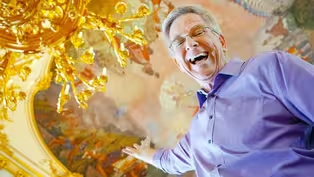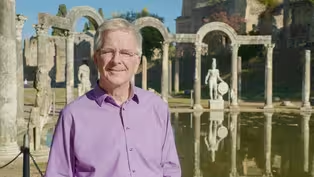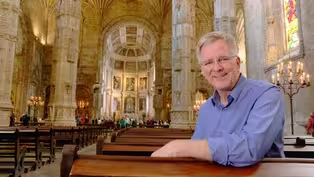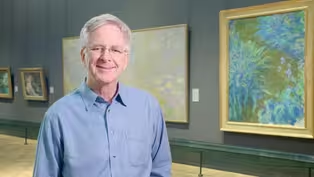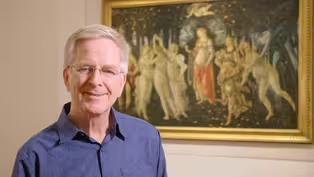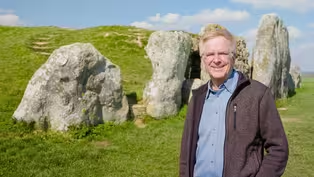Rick Steves' Europe
Germany's Hamburg and the Luther Trail
Season 9 Episode 901 | 26m 47sVideo has Closed Captions
Hamburg, Germany’s mighty port city has risen from the ashes of World War II
Hamburg, Germany’s mighty port city has risen from the ashes of World War II with a gleaming new skyline and a brisk creative energy. From there, Rick visits the great historic sights of Martin Luther and the Reformation (Erfurt, Wittenberg, and Wartburg Castle) before finishing in the capital of Franconia: wine-loving Würzburg.
Problems playing video? | Closed Captioning Feedback
Problems playing video? | Closed Captioning Feedback
Distributed nationally by American Public Television
Rick Steves' Europe
Germany's Hamburg and the Luther Trail
Season 9 Episode 901 | 26m 47sVideo has Closed Captions
Hamburg, Germany’s mighty port city has risen from the ashes of World War II with a gleaming new skyline and a brisk creative energy. From there, Rick visits the great historic sights of Martin Luther and the Reformation (Erfurt, Wittenberg, and Wartburg Castle) before finishing in the capital of Franconia: wine-loving Würzburg.
Problems playing video? | Closed Captioning Feedback
How to Watch Rick Steves' Europe
Rick Steves' Europe is available to stream on pbs.org and the free PBS App, available on iPhone, Apple TV, Android TV, Android smartphones, Amazon Fire TV, Amazon Fire Tablet, Roku, Samsung Smart TV, and Vizio.
Providing Support for PBS.org
Learn Moreabout PBS online sponsorshipMore from This Collection
Rick Steves, America's leading authority on European travel, returns to transport viewers to the continent's bustling cities, quaint villages and picturesque countryside.
Rick Steves’ Europe: Baroque Art
Video has Closed Captions
We marvel at Baroque’s over-the-top churches, palaces, bubbly fountains, and theatric art. (28m 22s)
Rick Steves’ Europe: Art of the Roman Empire
Video has Closed Captions
The grand cities of ancient Rome’s vast empire and majestic churches of its fall. (28m 23s)
Rick Steves’ Europe: Art of the Renaissance Beyond Florence
Video has Closed Captions
From Portugal to Germany, booming economies and new technologies produce exquisite art. (28m 42s)
Rick Steves’ Europe: Art of the Impressionists and Beyond
Video has Closed Captions
Shimmering Impressionist canvases by Monet and Renoir, plus Van Gogh, Gauguin and more. (28m 26s)
Rick Steves’ Europe: Art of the Florentine Renaissance
Video has Closed Captions
Florence’s bold “rebirth” is powered by the genius of Leonardo, Rafael, and Michelangelo. (28m 3s)
Rick Steves’ Europe: Art of Prehistoric Europe
Video has Closed Captions
We marvel at Stone Age cave paintings, mighty megaliths, and mysterious goddesses. (28m 4s)
Providing Support for PBS.org
Learn Moreabout PBS online sponsorship- Hi, I'm Rick Steves, back with more of the best of Europe.
This time we're enjoying some underappreciated corners of Germany, both old and new.
It's Hamburg and a whole lot more.
Thanks for joining us.
(gentle thrilling music) (gentle thrilling music ending) Germany is Europe's leading country in many ways.
It dominates Europe's economy today and has long had a huge impact on events shaping the continent.
We'll see that by exploring Hamburg, its mighty port city, and then heading south to the stomping grounds of a single monk who, 500 years ago, changed the world.
After enjoying Hamburg's inviting parks and lakes, we'll see how its architecture ranges from some of Hitler's leftover giant concrete bunkers to cutting-edge modern buildings.
We'll explore a vibrant counterculture neighborhood, and, after marveling at Hamburg's vast warehouse district, we'll take the best harbor tour in Europe sailing under its striking new skyline capped by a towering new concert hall.
Then we'll delve into the places where Martin Luther kicked off the Reformation 500 years ago, from the city where he preached and taught, to the castle in which he hid out from the Holy Roman Emperor.
We'll learn about the chaos he triggered, along with the progress.
Finally, for a contrast to all that stern Protestantism, we'll visit exuberantly Catholic Wurzburg and admire the elegance of its Residence, the palace of the prince bishops of Franconia.
In the heart of Northern Europe lies Germany.
After touring Hamburg, we head south to the Luther cities of Wittenberg and Erfurt, and finish in Wurzburg.
Hamburg is Germany's second largest city.
Like other second cities, Chicago, Glasgow, St. Petersburg, it has a spirited pride.
While yet to be discovered by American travelers, it's a popular destination with Germans for its music, theater, and riverside energy.
A century ago, Hamburg's port was the third largest in the world with strong connections both east and west.
Heavy damage in World War II devastated its commercial center.
During the Cold War which followed, trade to the east was cut off, port traffic dwindled and so did the city's influence.
But Hamburg's been enthusiastically rebuilt.
And since the reunification of Germany, just a generation ago, it's gaining back its former status as a leading trade center, and it's become one of Germany's most desirable places to live.
The city's delightful lakes were created in the Middle Ages when townsfolk built a mill that dammed the local river.
Back in the 1950s, a law guaranteed public access to the lake for everyone.
And today, peaceful paths and bike lanes are a hit with locals.
On a nice day, the lake is dotted with sailboats.
On the far side, lush inlets reach into fancy residential neighborhoods.
Along with plenty of downtown parkland, the lakes provide Hamburg, one of Germany's greenest cities, with an elegant promenade that comes complete with top-of-the-line shops.
Just a block away, its massive city hall, built in the 19th century, overlooks the lively scene.
It's flanked by graceful arcades and surrounded by plenty of commerce.
It's bold architecture and maritime atmosphere gives this northernmost German city an almost Scandinavian feel.
With its trading heritage and a strong economy, Hamburg's downtown showcases a wealthy city that rose like a phoenix from a terrible recent past.
(gentle music) You'd hardly know that this was one of the most heavily bombed cities in Germany in World War II.
With its strategic port, munitions factories, and transportation links, Hamburg was a prime target for Allied bombers.
American and British commanders had an innovative plan with a horrific goal.
Its name?
Operation Gomorrah.
On July 27th, 1943, they hit targets first with explosive bombs to open roofs, break water mains, and tear up streets.
The purpose?
To make it hard for firefighters to respond.
Then came a hellish onslaught of incendiary bombs.
700 bombers concentrated their attack on a relatively small area.
The result was a firestorm never seen before.
The intensity of the bombs actually created a tornado of raging flames reaching horrific temperatures.
(poignant music) Thousands suffocated inside their air-raid shelters, and those outside were sucked off their feet disappearing up into the fiery vortex.
In three hours, the inferno killed over 35,000 people, left hundreds of thousands homeless, and reduced eight square miles of Hamburg to rubble and ashes.
Somehow the towering spire of St. Nicholas Church survived the bombing.
It and the ruins of the church itself are now a memorial left to commemorate those lost and to remind future generations of the horrors of war.
Where the original altar once stood is now a simply, yet poignant, concrete altar by Oskar Kokoschka.
The memorial's underground museum quietly tells the story.
You'll see scorched and melted fragments demonstrating the heat of the firestorm, and examples of the futility of trying to survive such a bombing.
The museum also shows foreign cities that Germany destroyed.
That's because Germans make a point to acknowledge the suffering they inflicted on others when remembering their own suffering.
(poignant music) Though Hamburg is mostly rebuilt, many World War II-era bunkers were just too solid to destroy.
So they survive, incorporated into today's contemporary scene.
This mammoth structure has 10-foot thick reinforced concrete walls.
With windows cut through the concrete, it's surprisingly inviting.
While once hosting gunners trying to shoot down Allied planes, today, bomb-hardened staircases lead to music shops and dance clubs.
(drums beating) And drummers here will never draw complaints from their neighbors.
(drums beating) (gentle upbeat music) Nearby, another bunker, this one with colorful graffiti, is now a climbing wall in a pleasant neighborhood park.
While Germany is known for its order and efficiency, that social conformity comes with a flip side, neighborhoods well known for their energetic counterculture.
Hamburg's trendy Schanze quarter offers a breath of fresh cultural air.
A popular neighborhood, it has so many cafes, its main street is nicknamed "Latte Macchiato Boulevard."
This fun-loving edge is nothing new to Hamburg.
(gentle upbeat music) Nearby, Hamburg's Reeperbahn neighborhood has long been Germany's most famous entertainment zone.
It gained notoriety as a rough and sleazy sailors' quarter filled with nightclubs and brothels.
But, as the city's changed, so has its entertainment district.
In one generation, the Reeperbahn has earned a new, more respectable image, a destination for theater and live music.
Today this street, where the Beatles launched their careers back in 1960, is a fun scene lined with playhouses.
Considered the Broadway of Germany for its many musicals, the boulevard attracts theatergoers from all over the country.
Hamburg, 60 miles from the North Sea, on the Elbe River, has long been a vital port.
Its waterfront is designed to accommodate the Elbe's 13-foot tides.
And, in anticipation of a rising sea level and potentially devastating storm surges, miles of embankments have recently been fortified.
Along with making the city safer, this stretch comes with a design element that gives Hamburg a delightful new park-like stretch of harbor front.
(gentle bright music) Long a busy ferry terminal, this floating dock is now a thriving tourist zone.
From here, with the aroma of pickled herring and French fries, you can enjoy the harbor and the energy of the city's port.
For German Americans, Hamburg has a special meaning, because their ancestors likely sailed from this harbor.
Between 1850 and 1930, millions of Germans emigrated to the United States from right here.
The port has always been a central feature of Hamburg.
It evolves and grows with the city's needs, and with changes in shipping technology.
The vast Speicherstadt, or "Warehouse City," was originally a seemingly endless grid of riverside warehouses.
Today, these buildings, once filled with cotton, rubber, and tobacco, house engaging museums, offices, and hip restaurants.
While those venerable warehouses survived, much of Hamburg's old port was abandoned when the shipping industry moved to a larger and more modern port nearby.
Then, a generation ago, the city realized that what had become a derelict industrial wasteland was potentially prime real estate.
The result, HafenCity, a huge urban development project.
With this new green and integrated urban center, downtown Hamburg became about 40 percent bigger, and, once again, the city faces its river.
The re-energized district seems a city in itself, mixing its maritime heritage with striking modern architecture.
Worked into the plan are both high-end condos and affordable subsidized housing.
Hamburg has created a healthy mix of business, culture, and leisure, convenient for the modern citizen without a car.
Today, city planners from around Europe look to Hamburg for inspiration in designing integrated urban centers.
The centerpiece of HafenCity is the striking Elbphilharmonie, a combination concert hall, public plaza, hotel, and apartment complex.
Its daring design and huge size fit in well with the massive scale of the surrounding port.
And, when approached by water, it resembles the looming prow of the steamer ships that first put Hamburg on the world map.
(gentle bright music) An unforgettable capper to a Hamburg visit is its harbor tour, the best of its kind in Europe.
You'll see plenty of Hamburg's bold new architecture, as well as its more established beach communities, lined with mansions.
But mostly, the hour-long cruise gets you up close to Hamburg's shipping industry, all those enormous container ships, towering cranes, and dry docks.
Accommodating 12,000 vessels a year, it's Europe's second-busiest harbor and earns the tag-line "Europe's gateway to the world, and the world's gateway to Europe."
Germany is compact, with an impressive infrastructure.
Within a few hours, we're in Eastern Germany, and Martin Luther Country.
In 1517, the German monk Martin Luther was a professor here in the university town of Wittenberg.
As professors routinely did back then, he tacked some points for discussion on the door of the church, which served as a kind of bulletin board for the university community.
These 95 points, questioning practices of the Roman Catholic Church, kicked off more than a discussion.
They kicked off the Protestant Reformation.
Martin Luther unleashed a world of change.
The Reformation was a political and theological storm that divided Christendom in Western Europe into Roman Catholics and Protestants.
It ignited a century of religious wars and, along with the humanism of the Renaissance, it helped bring western civilization out of the Middle Ages and into the modern world.
2017 marked the 500th anniversary of the Protestant Reformation, and Eastern Germany is famous for its Lutherstadts, or "Luther cities," and sights associated with that tumultuous time.
The three most interesting Reformation stops are Erfurt, where Luther studied and first became a monk; Wartburg, the castle where he famously hid out and translated the "Bible" into German; and Wittenberg, where he taught, preached, and led the Reformation.
Luther went to law school here in Erfurt, and today, this half-timbered medieval town, with a shallow river gurgling through its center, remains an charming destination that Luther himself would recognize.
Erfurt's atmospheric Merchants' Bridge is lined with shops and homes.
Then, as now, merchants live upstairs above their shops.
This is the land of fairy tales and the Brothers Grimm, fine woodcarvers, and fanciful puppets.
You can peek into the workshop of Martin Gobsch.
Observe him at work.
And don't leave without popping a coin into his tiny theater.
(gentle whimsical music) The evil queen welcomes you into the dreamy world of Snow White.
Separate vignettes tell the story.
(gentle whimsical music) It all leads to the happy ending, when the charming prince whisks Snow White away.
Back in 1505, as a young student, Martin Luther became a monk in Erfurt's Augustinian monastery.
In this church he gave his first Mass.
Its little museum includes Luther artifacts and the simple cell where the novice monk lived.
Little did they know that this humble novice would change the course of European history.
Nearby is Wittenberg.
Around 1500, the local ruler, Frederick the Wise, was establishing the town as his capital.
He invited young Martin Luther to join the faculty of his university.
The main square is dominated by its town hall and a statue remembering the "Great Reformer."
Wittenberg's top sight is the Lutherhaus, where Luther lived.
Today, it's an excellent museum displaying original artifacts, the pulpit from which Luther preached, portraits of Luther and the other reformers, and the "Bible" Luther boldly translated from Latin into the people's language.
500 years ago, the selling of forgiveness and church corruption stoked public discontent with the Roman Church, which led to the Reformation.
This is a letter of indulgence, one of countless fundraising coupons the Church issued.
These were sold to the faithful for religious favors such as reducing time for dead loved ones in purgatory.
Their money would fill boxes like this, and eventually ended up in Rome to fund the pope's lavish world.
Corruption like this inspired Luther to confront the Church.
And it was the invention of the printing press with movable type by Gutenberg in the same generation that enabled reformers like Luther to spread their ideas.
Luther wrote in the peoples' language, and sold more than a quarter million booklets like these.
Like social media empowers popular movements today, Luther's pamphlets went viral.
He was the bestselling German writer of the 16th century.
The Wartburg Castle is a popular stop on the Luther trail.
When Luther spoke out against Church corruption, he was declared an outlaw and needed to run for his life.
A sympathetic German prince gave him refuge.
Disguised and under a fake name, Luther hid out here in this castle.
The actions of this solitary monk brought far-reaching changes.
Believing that everyone should be able to read the word of God, Luther began the daunting and dangerous task of translating the New Testament from the original Ancient Greek into German.
He used simplified language, as he said, "Like a mother talking to her children."
Just as the King James version of the "Bible" did for English, Luther's translation helped to establish a standard German language that's used to this day.
Luther's translation brought the "Bible" to the masses.
As Germans actually read the "Bible," they saw, as Luther had, that there was no mention of indulgences, purgatory, or even a pope.
Just as the Church had feared, this further fanned the fires of reform.
This part of Germany was ground zero for the century of religious wars Luther's reforms unwittingly unleashed.
A vivid portrayal of that tumultuous time with an intriguing communist twist can be seen above the town of Bad Frankenhausen.
It's a huge 360-degree panoramic painting commissioned in the 1980s by the communist East German government.
(gentle dramatic music) "The Peasants' War Panorama," 400 feet around, was painted as communist propaganda.
It remembers the 6,000 peasants who were slaughtered in a single battle.
Armed with little more than shovels, they rose up against the Church and the ruling class during the Reformation.
The detail is vivid.
(gentle dramatic music) Using this popular revolt 500 years ago, it hammers home a familiar theme during the Cold War.
Whether 16th-century peasants or 20th-century workers, the people's struggle is long and ongoing.
(gentle dramatic music) The panorama portrays more than just a horrible battle.
It represents the bloody transition between the medieval and the modern worlds.
At the base gather 20 great humanists, change agents at the end of the Middle Ages, Luther, Erasmus, Copernicus, Columbus, and more.
Above them rages the colossal battle under a rainbow, imperial troops on the left, doomed rabble on the right.
Nearby, an aristocratic couple dances before a gallows.
The message?
The elites continue to win.
(gentle dramatic music) Until German unification in the late 1800s, Germany was fragmented, a collection of small independent states.
After the Reformation, those in the north ended up Lutheran, or Protestant, and those in the south remained Roman Catholic.
A few hours south of Luther Country takes us across that religious divide and into the enthusiastically Catholic region of Franconia and its capital city, Wurzburg.
Wurzburg is surrounded by vineyards and straddles the Main River.
Like so many German cities, it was devastated by World War II bombs.
But, while cities like Hamburg and Frankfurt rebuilt on a modern grid plan, Wurzburg recreated its charm by rebuilding according to its original layout.
The marketplace is an inviting scene.
Its 200-year-old obelisk features Romantic maidens selling their produce.
And to this day, the square still hosts a charming market.
(gentle bright music) This tourist-friendly town is easy to navigate by foot or by streetcar.
Today, nearly a quarter of its 130,000 residents are students, making the town feel young and vibrant.
The town bridge, from the 12th century, is one of Germany's oldest.
It's decorated with statues of Wurzburg's favorite saints and princes.
And it's busy with people out and enjoying the moment.
Scenes like this are ideal for connecting with locals.
(gentle bright music) Wurzburg was the capital of the German state of Franconia.
In the 1700s, it was ruled by a prince-bishop.
He exercised both secular and religious authority, and this grand palace was his home.
Opulent as a German Versailles, the prince-bishop's Residence is the main attraction of Wurzburg.
Imagine VIP guests arriving for lavish parties.
Met here by the prince-bishop, they'd glide gracefully up this elegant stairway, enjoying a grand fresco as it opens up overhead.
Dating from about 1750 and by the Venetian master Tiepolo, it illustrates the greatness of Europe with Wurzburg at its center.
The hero is the esteemed prince-bishop, honored by a host of Greek gods affirming his rule.
Ringing the room are allegories of the four continents, each with a woman on an animal and celebrating Wurzburg as the center of the civilized world.
America, desperately uncivilized, sits naked with feathers in her hair on an alligator among severed heads and a cannibal barbecue.
(sophisticated classical music) Africa lounges on a camel in a land of trade and fantasy animals.
Asia rides her elephant in the birthplace of Christianity, marked by crosses.
Europe is the center of high culture, and Lady Culture herself points her brush not at Rome, but at Wurzburg.
The adjacent Imperial Hall is a fine example of Baroque, harmony, symmetry, light, and mirrors.
Its ceiling is also by Tiepolo.
Typical of the Baroque movement, he was a master of three-dimensional illusion, and he'd heighten the illusion with some fun tricks.
Notice how 3D legs and other objects dangle out of the 2D frame.
The art, like nearly all art of that day, was propaganda, paid for and serving either the State or the Church.
In this case, it's both.
Here, the Holy Roman Emperor bestows upon the bishop of Franconia the secular title of prince.
The bishop, now the prince-bishop, touches the emperor's scepter, performing an oath of loyalty.
From this point onward, the prince-bishop wears two very powerful hats at the same time.
A string of splendid rooms evolve from fancy Baroque to fancier Rococo.
It all leads to the 18th-century Mirror Cabinet.
This was where the prince-bishop showed off his amazing wealth.
It features kilos of gold leaf, lots of exotic Asian influence, and eye-popping extravagance.
As for the commoners, we were finally allowed inside this glorious palace about two centuries later.
(sophisticated classical music) I hope you've enjoyed our visit to dynamic Hamburg, the fascinating Luther cities, and Wurzburg, with its Baroque charm.
I'm Rick Steves.
Until next time, keep on travelin'.
Auf Wiedersehen.
As public media embraces the convenience of streaming, we're still public media, and that means your support is as critical as ever.
Please, take a moment to support this station.
It's quick, it's easy, and when you get on board, you'll help make quality programming strong for your entire family.
And along with these gifts, you'll enjoy a world of great programs with Passport.
Thanks a lot.
(gentle bright music) - [Announcer] Invest in your local PBS station by becoming an $8 monthly sustainer, or make a $96 annual contribution right now and we'll say thanks with a wonderful collection of gifts.
You'll receive Rick Steves' book "For the Love of Europe," which shares his favorite memories from decades of travel in 100 essays.
It's 400 pages of fun and inspirational travel stories.
On top of that, you'll receive a copy of "Europe Through the Back Door."
This book is packed with practical tips, from chapters on packing light and planning a smart itinerary, to eating your way through Europe and finding great hotels.
We'll also send you this map of Europe, which is perfect for pre-trip planning and using while you're on the vacation of your dreams.
Plus, you'll receive Rick Steves' newsletter, which is packed full of travel tips about European destinations.
And don't forget, with your qualifying contribution, you'll be able to enjoy a terrific member benefit, PBS Passport, which lets you watch every one of Rick's shows that's available on the PBS app.
With PBS Passport, you'll also be able to stream a treasure trove of your favorite dramas, history, arts, music, and more.
So don't wait.
Go to pbs.org/rick to give now.
Thank you.
(gentle bright music) - That what had become a derelict industrial wasteland was actually prime real estate.
(Rick laughing) The prince-bishop's Residence is the main attraction in Hamburg.
(laughs) Ahman's a Debbie Downer when it comes to 16th century history.
If there's anybody that can cheer for the Reformation.
Kicked off more than a conversation.
(clicks tongue) They kicked off the Protestant Reformation.
(gentle thrilling music) (gentle thrilling music ends) (gentle music) (gentle music)
Support for PBS provided by:
Distributed nationally by American Public Television
